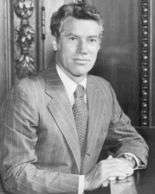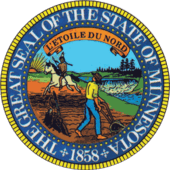Wendell Anderson
| Wendell Anderson | |
|---|---|
 | |
| United States Senator from Minnesota | |
|
In office December 30, 1976 – December 29, 1978 | |
| Preceded by | Walter Mondale |
| Succeeded by | Rudy Boschwitz |
| 33rd Governor of Minnesota | |
|
In office January 4, 1971 – December 29, 1976 | |
| Lieutenant | Rudy Perpich |
| Preceded by | Harold LeVander |
| Succeeded by | Rudy Perpich |
| Personal details | |
| Born |
Wendell Richard Anderson February 1, 1933 St. Paul, Minnesota, U.S. |
| Died |
July 17, 2016 (aged 83) St. Paul, Minnesota, U.S. |
| Nationality | American |
| Political party | Democratic |
| Spouse(s) | Mary McKee |
| Alma mater | University of Minnesota, Twin Cities |
| Military service | |
| Allegiance |
|
| Service/branch |
|
| Years of service | 1956–1957 |
Wendell Richard "Wendy" Anderson (February 1, 1933 – July 17, 2016) was an American politician and the 33rd governor of Minnesota, serving from January 4, 1971, to December 29, 1976. In late 1976, he resigned as governor in order to be appointed to the U.S. Senate after Senator Walter Mondale was elected Vice President of the United States. Anderson served in the Senate from December 30, 1976, to December 29, 1978 (after losing the 1978 Senate election to Rudy Boschwitz, he resigned a few days before the end of his term to give Boschwitz seniority).[1][2]
Background
Anderson was born in Saint Paul, Minnesota in 1933. He attended Saint Paul's Johnson High School and the University of Minnesota, where he received a B.A. in 1954. He served in the United States Army in 1956-57 and earned a law degree from the University of Minnesota Law School in 1960.
Hockey career
Anderson played defense for the University of Minnesota from 1951 to 1954, and was a member of the U.S. hockey team that won a silver medal at the 1956 Winter Olympics. Long after his on-ice career ended, he was drafted by the Minnesota Fighting Saints in the inaugural World Hockey Association draft of 1972, in what was seen as a publicity stunt. (Not to be outdone, another WHA team selected Soviet Premier Alexei Kosygin.) While flattered, Anderson chose to remain governor.
Political career
Anderson served in the Minnesota House of Representatives from 1959 to 1962 and in the Minnesota State Senate from 1963 to 1970.[3] His signature accomplishment as governor was helping to create the "Minnesota Miracle of 1971," an innovative reform in financing of Minnesota public schools and local governments that created a fairer distribution in taxation and education. For his efforts, Anderson was featured on a 1973 cover of Time magazine.[4]
After U.S. Senator Walter Mondale was elected vice president in 1976, the governor needed to appoint Mondale's successor. Anderson agreed with his lieutenant governor, Rudy Perpich, that Anderson would resign as governor, and Perpich, as the new governor, would appoint Anderson senator.
In what became known as the "Minnesota Massacre", nearly the entire DFL Party ticket was defeated in 1978, including Perpich and the candidates for both U.S. Senate seats, Anderson and Bob Short. Anderson's arrangement to have himself appointed to the Senate—and Perpich's role in that appointment—were deemed central factors in the defeats.
From 1995 to 2001, Anderson served as a director for and head of the legal committee of Turbodyne Technologies Inc. (TRBD) in Carpinteria, California. In his later years, he was regularly called upon to act as a commentator on Minnesota politics for local stations, such as KSTP-TV.[5]
Personal
Anderson married Mary Christine McKee of Bemidji, Minnesota, in 1963. They had three children: Amy, Elizabeth, and Brett. They divorced in 1990. In 1975, Anderson was honored by two of the Swedish District lodges of the Vasa Order of America and selected as Swedish-American of the Year.[6] He died on July 17, 2016, of complications of Alzheimer's disease.[7]
References
- ↑ "About Governors of Minnesota : mnhs.org". Retrieved July 18, 2016.
- ↑ Nathanson, Iric (October 27, 2010). "'Spendy Wendy' and the 1970 gubernatorialelection". MinnPost. Retrieved October 3, 2014.
- ↑ "Anderson, Wendell Richard "Wendy" - Legislator Record - Minnesota Legislators Past & Present". Retrieved July 18, 2016.
- ↑ "TIME Magazine Cover: Governor Wendell Anderson - Aug. 13, 1973". Retrieved July 18, 2016.
- ↑ "Anderson, Wendell Richard "Wendy" - Legislator Record - Minnesota Legislators Past & Present". Retrieved July 18, 2016.
- ↑ Wendell R. Anderson (Vasa Order of America)
- ↑ "Wendell Anderson, former Minnesota governor, dead at 83". Retrieved July 18, 2016.
External links
- Wendell Anderson at Minnesota Legislators Past & Present
- United States Congress. "Wendell Anderson (id: A000202)". Biographical Directory of the United States Congress.
- Wendell Anderson on the cover of TIME magazine: August 13, 1973
| Party political offices | ||
|---|---|---|
| Preceded by Karl Rolvaag |
Democratic nominee for Governor of Minnesota 1970, 1974 |
Succeeded by Rudy Perpich |
| Preceded by Walter Mondale |
Democratic nominee for U.S. Senator from Minnesota (Class 2) 1978 |
Succeeded by Joan Growe |
| Political offices | ||
| Preceded by Harold LeVander |
Governor of Minnesota 1971–1976 |
Succeeded by Rudy Perpich |
| United States Senate | ||
| Preceded by Walter Mondale |
United States Senator (Class 2) from Minnesota 1976–1978 Served alongside: Hubert Humphrey, Muriel Humphrey, David Durenberger |
Succeeded by Rudy Boschwitz |

